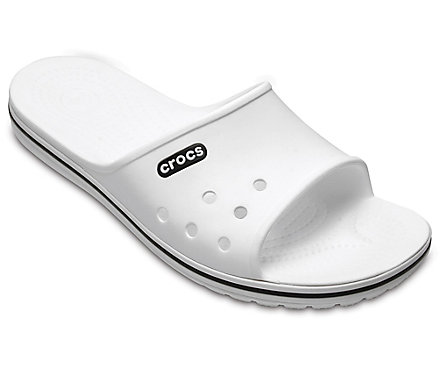Do those eye-catching shoes have a place in good health?
Crocs: Healthy Shoes or Just Comfy? Crocs — those clog-like shoes in bright colors — might not match everyone’s idea of fashion, but fans swear by their comfort. And Croc lovers say they bring health benefits to the two extremities that carry us all to the places we go.
Are Crocs really good for our feet? WebMD got some feedback from doctors, consumers, and the shoe’s creators.
A History of the Croc 
Born in 2002, the shoe was initially intended as footwear for boating, with its nonslip tread and waterproof tendencies.
“The product was originally produced in Canada in clog-form,” says co-founder Lyndon V. Hanson, III, vice president of Crocs. “We added a strap for utility, and gave it some flair.”
Crocs are certified by the U.S. Ergonomics Council and the American Podiatric Medical Association. Hanson says that what Crocs lack in aesthetic value, they make up in therapeutic benefits. The company created what it calls an Rx line of models specifically with healthy feet in mind: Croc Relief, Croc Cloud, and Croc Silver Cloud.
“These shoes were designed specifically to eliminate plantar pain and achy feet,” says Hanson. “They also help people with injured feet, bunions, and diabetes. You’ve got a lot of inner support, heel cups and massaging heel nubs, and arch support. They’re ideal for people with foot problems.”
Pros And Cons Of Croc Shoes
Pros:
Easy cleanup – Crocs are great for activities that could get your feet muddy, such going to the beach, gardening, or visiting a dog park.
It’s really easy to wash them so there is no hassle at all.
Really Comfortable – Most people find the shoe to be convenient and comfortable due to its lightweight design and strong arch support.
Easily Absorbs Shocks – When walking on hard floors, the padded shoes alleviate the impact on the feet, ankles, and back.
They Are Always Wide Enough – The simple option of buying a size larger may not always work for people with wide feet.
The toe box section of Crocs is not overly constricting, which is advantageous for people with foot edoema or foot abnormalities like bunions or hammertoes.
Cons:
Cannot Secure Your Feet – Everybody and everything has weaknesses, and crocodiles are not an exception. Since crocs are bad for your health, doctors have expressed their concerns about wearing them. A podiatrist claims that wearing crocs all day is not recommended. You shouldn’t wear the crocs for extended periods of time because they are insufficient for holding the heel in place.
Tendinitis can result from the toes becoming exposed when the heels are out of alignment and unstable. Other issues that you can encounter include corns, toe abnormalities, and nail issues.
Blisters May Appear – You must be shocked to learn that croc wearers frequently lament their smelly feet. Your feet sweat in the crocs’ rubber, and as they perspire more, they begin to smell.
Even wearing socks under them won’t make much of a difference. Imagine the danger this rubber poses if it can cause socks to perspire. Nobody enjoys having stinky feet, therefore if you prefer crocs, wear them only sometimes.
What are the key considerations when selecting a cros?
When considering Cros footwear, here are key factors to take into account:
- Purpose: Determine the intended use of the footwear. Are you looking for Cros shoes for running, walking, hiking, or casual wear?
- Comfort: Check the comfort level of the shoes. Consider factors like cushioning, arch support, and overall fit. Look for features like padded insoles or breathable materials.
- Durability: Assess the quality and durability of the materials used. Consider the construction, stitching, and overall build of the shoes to ensure they will withstand regular wear and tear.
- Style: Determine if the style of the Cros footwear aligns with your personal preference and fits well with your wardrobe. Consider color options and design details.
- Traction: Evaluate the outsole of the shoes for good traction, especially if you plan to use them for activities like hiking or running on different terrains.
- Fit and Sizing: Look for accurate sizing information provided by the manufacturer. Read reviews or consider trying on the shoes in person to ensure the right fit for your feet.
- Breathability: Consider the breathability of the shoes, especially if you will be wearing them for extended periods or during physical activities. Look for features like mesh panels or moisture-wicking materials.
- Price: Determine your budget and compare the price of Cros footwear with similar options in the market. Consider the value offered in terms of features, quality, and durability.
- Customer Reviews: Read customer reviews and ratings to gather insights into the overall satisfaction and performance of the Cros footwear.
- Return and Warranty Policies: Familiarize yourself with the return policy and warranty coverage provided by the manufacturer or retailer in case you encounter any issues with the footwear.
By considering these factors, you can make a more informed decision when selecting Cros footwear that aligns with your specific needs and preferences.
Crocs in the Clinic
Some doctors are even recommending them to patients with foot problems.
“These shoes are especially light,” says Harold Glickman, DPM, former president of the American Podiatric Medical Association (APMA). “They have huge room in the toe that affords the front part of the foot lots of room, especially for people with bone deformities like bunions and hammer toe. With the Rx Crocs, they’re lined with antibacterial material that will prevent fungal and bacterial infections.”

